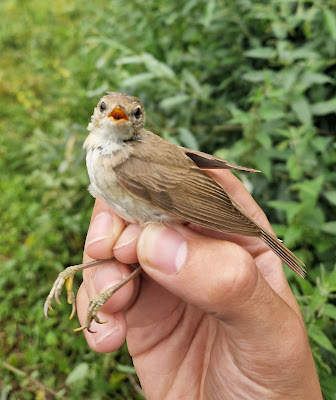Continuing the theme of arrested/suspended moult I searched through some of our Demon records today. Between 1/1/18 and 1/1/23 we have processed 28,754 birds; of these, 17 are recorded as having arrested their moult (as arrested is the only option in Demon, I will just use this term from now on).
Of these 10 were female:
1 – Lesser Redpoll
1 – Whitethroat
2 – Greenfinch
6 – Goldfinch
5 were male:
1 – Garden Warbler
1 – Greenfinch
3 – Goldfinch
and 2 were unsexed:
1 – Whitethroat
1 – Goldfinch (though provisionally sexed as a female).
These totals don't include Holly's whitethroat, or my Linnet (see below), as these were recorded as in main moult but looking likely to have arrested their moult, which makes me wonder how many others were like this. (Also, its unlikely we would have recorded arrested moult in the secondary feathers).
Two things which jump out from our totals are -
1 - the number of Goldfinch. Could it be that perhaps we have caught more of these or perhaps a moult limit is easier to see, I don't know.
2 - the number of males. The article – Moult interruption in passerines resident in Britain by D G C Harper, found that this had only been recorded in females, though more information was needed.
And a final word from D G C Harper in their 1984 article -
“The increasing number of non-migratory birds in which moult interruption associated with breeding has been recorded suggests that ringers should pay careful attention to birds caught during the moult period that are not in active moult. Although the paucity of previous records of moult interruption in such species is probably a reflection of the low frequency with which it occurs, it may also reflect a tendency for observers to assume that birds whose feathers are all fully grown have either not started or have completed their moult”.
Mick P









